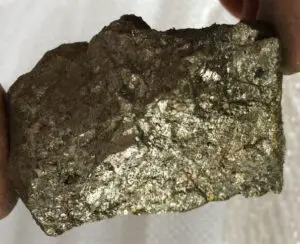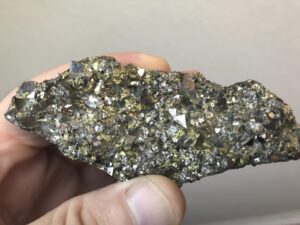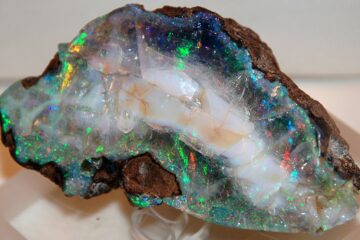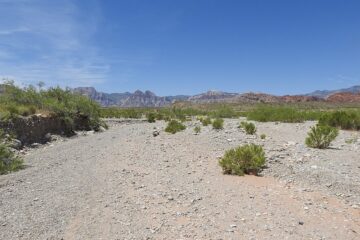Pyrite, or iron pyrite, also known as fool’s gold, is an iron disulfide mineral containing iron and sulfur. The name fool’s gold comes from novice prospectors commonly mistaking it for gold. Pyrite has a brassy sheen, and unlike gold which is malleable, pyrite will crush into a brown powder.
Pyrite in Sulfide and Oxidized Ores
Pyrite is often formed in hydrothermal ore deposits associated with quartz, and in fact pyrite in these types of deposits may contain gold in valuable quantities.
The gold ores in arid desert regions generally contain much less pyrite and other metallic sulfides than ores in areas with high precipitation. Because of the usual low water table in desert areas, the corrosive action of oxygen is able to react with the pyrite, rapidly turning it into iron oxides which resemble rust.
The gold ores in areas with high precipitation and in turn a high or shallow water table may have very little oxides in them. They may be formed almost entirely of massive or disseminated pyrite and other sulfides in association with quartz or other siliceous rocks.
The weathering of pyrite masses and cubes into iron oxides creates a distinctive appearance of one or more colors. Various shades of brown, orange, red or yellow.
See my post How to find gold-high grade gold ore for more information on oxidiized gold ores
Any iron stained quartz outcrop should be thoroughly investigated for gold values. Especially heavily oxidized quartz with cavities or vugs created by the weathering of pyrite. There may be minor amounts of pyrite within oxidized ore and a jewelers loupe may be a good idea. Small specks of pyrite can be mistaken for gold, even by experienced prospectors.
If an ore contains even a moderate amount of pyrite, it can be difficult to process or refractory in nature. The gold can be mechanically locked up within the pyrite and processes such as roasting, pressure leaching or bioleaching need to be employed. Any of these methods require expensive infrastructure and are well beyond the reach of the small miner.
Even if the gold is not locked in the pyrite, it makes gravity separation difficult. The heavy sulfide will pack into sluice box riffles rendering them ineffective. Concentrating tables even have limited effectiveness in processing pyrite ores.
In the desert southwest we are blessed with many low or no sulfide ores. These are usually free milling ores and can often have significant gold values.
In addition to iron pyrite there are two other pyrites with a white to yellow metallic appearance. Chalcopyrite which is an iron copper sulfide and arsenopyrite, an iron arsenic sulfide.
Chalcopyrite can contain 35 to 40 percent copper and weathers into the bright blues and greens of azurite and malachite which are copper carbonates. It is an important ore of copper and is sometimes even more of a gold color than iron pyrite. It is also often mistaken for gold. It can also take on a metallic purple iridescence, hence the name peacock ore.
Arsenopyrite is usually a pale metallic whitish yellow. Care should be taken if roasting sulfide ores as arsenopyrite may be present. The fumes are obviously quite toxic.
All three pyrites may be present in a gold ore in varying amounts. None are magnetic.
Personally I avoid trying to process gold ore with even moderate amounts of metallic sulfides.
The gold values are usually lower than oxide ores and the difficulty of recovering the gold from the sulfides makes it hard to justify the extra cost and time.






